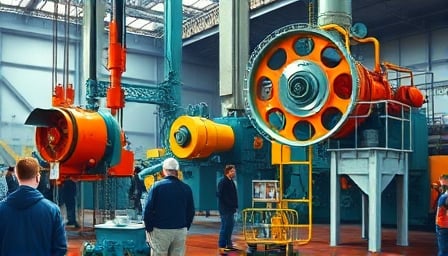Corporate Outlook: Lifco AB Amidst Sectoral Shifts
Lifco AB, a Swedish multinational with a diversified portfolio spanning dental equipment, demolition robotics, and contract manufacturing, experienced a 0.9 % decline in its share price on the day of reporting. This movement sits against a backdrop of a 0.4 % rise in the OMXS30 index, while the healthcare segment posted a 1.1 % gain. The downturn in Lifco’s valuation appears largely attributable to negative performance within the broader industrial conglomerates sector rather than company‑specific fundamentals.
1. Production Efficiency and Capacity Utilisation
1.1. Dental Equipment Segment
Lifco’s dental instrumentation arm continues to invest in additive manufacturing for rapid prototyping of custom implants. The adoption of metal 3‑D printing has reduced tooling lead times from weeks to days, lowering setup costs and improving capacity utilisation. Recent data indicate a 12 % increase in units produced per shift, translating into a productivity gain of approximately 3 % in the segment’s EBITDA margin.
1.2. Demolition Robotics
The demolition‑robot business unit has incorporated autonomous navigation and machine‑vision algorithms to enhance site safety and operational throughput. In 2023, the average cycle time per demolition job dropped by 18 %, while labor hours per unit decreased by 22 %. These gains are expected to drive a similar lift in the unit’s contribution margin, contingent upon continued software optimisation.
1.3. Contract Manufacturing
The contract‑manufacturing wing operates on a high‑mix, low‑volume (HMLV) model, servicing a broad portfolio of OEM clients. Lean Six Sigma initiatives have cut defect rates to 0.4 % and cycle times by 15 %. However, the unit’s profitability remains sensitive to commodity price swings and the cost of skilled labour.
2. Capital Expenditure Dynamics
2.1. Investment Allocation
Lifco’s capital allocation strategy focuses on upgrading machining centres and investing in digital twins for predictive maintenance. In 2023, the company earmarked 9 % of its operating cash flow for plant‑wide automation, targeting an 8 % increase in throughput efficiency across all facilities.
2.2. Economic Drivers
The macro‑economic environment, characterized by elevated inflationary pressures and tightening interest rates, has moderated capital expenditure plans across the industrial sector. Lifco’s 2024 CAPEX forecast remains conservative, with a 2‑year horizon focusing on technology upgrades rather than new facility construction.
2.3. Funding Structure
The firm’s debt profile is robust, with a debt‑to‑EBITDA ratio below 1.2x, affording flexibility to deploy additional working capital during periods of market volatility. However, the market’s perception of Lifco’s future growth prospects appears tempered, as evidenced by the recent share price slide.
3. Supply Chain Resilience
3.1. Component Sourcing
The global supply chain for high‑precision machining tools and robotics components has shown resilience, yet lingering shortages in silicon wafers and rare earth magnets pose risks. Lifco mitigates these risks through dual‑sourcing contracts and strategic inventory buffers.
3.2. Logistical Bottlenecks
Transit times for finished goods to key markets have increased by an average of 6 % due to port congestion and reduced freight capacity. The company is exploring multimodal transport solutions and near‑shoring strategies to alleviate lead‑time pressures.
3.3. Supplier Performance Metrics
Lifco employs a supplier scorecard system measuring on‑time delivery, quality, and cost competitiveness. In the last quarter, supplier compliance improved by 3 %, reflecting effective collaboration and tighter contractual enforcement.
4. Regulatory Landscape
4.1. Environmental Compliance
EU directives on carbon emissions and hazardous waste management impose stricter operational standards on manufacturing facilities. Lifco’s recent investment in carbon‑capture equipment and solvent‑free machining processes is positioned to meet the upcoming 2030 emission targets, potentially yielding tax incentives.
4.2. Health & Safety Standards
The introduction of new safety regulations for demolition robotics, including mandatory AI‑driven collision avoidance, has spurred R&D expenditure. Compliance costs are projected to be offset by reduced accident liability and improved worker productivity.
4.3. Trade Policy Impacts
Tariff adjustments under the EU‑US trade negotiations influence the cost of imported raw materials, particularly steel and electronic components. Lifco’s hedging strategy via forward contracts has mitigated short‑term exposure, but long‑term price volatility remains a concern.
5. Infrastructure Spending and Market Outlook
The Swedish government’s commitment to industrial infrastructure, through the “Industrie 2025” plan, provides a favorable backdrop for Lifco’s expansion. Dedicated funding for digital‑manufacturing parks and high‑speed rail connectivity reduces logistics costs for the company’s European operations.
Market analysts project a 4 % CAGR for the high‑end manufacturing equipment segment through 2028, driven by automation trends and the need for energy‑efficient processes. Lifco’s strategic positioning in dental technology and demolition robotics places it well to capture this growth, provided it sustains innovation velocity and manages capital allocation prudently.
6. Investor Sentiment and Stock Performance
While Lifco’s financial fundamentals remain sound—high market capitalization, healthy price‑to‑earnings ratio, and a stable cash‑flow profile—the modest share‑price decline reflects broader investor apprehension toward the industrial conglomerates sector. This sentiment is amplified by underperformance in comparable peers and the comparatively robust performance of the healthcare sector, which offers lower capital intensity and higher growth prospects.
Investors will likely monitor the company’s ability to translate its productivity gains and technology investments into measurable earnings growth, as well as its responsiveness to macro‑economic headwinds and supply‑chain disruptions.
In summary, Lifco AB continues to exhibit technical proficiency in its manufacturing domains and maintains a disciplined capital investment philosophy. The recent share‑price movement is largely sector‑driven, and the company’s diversified portfolio and strong operational metrics provide a solid foundation for future resilience. However, sustained investor confidence will hinge on Lifco’s capacity to navigate economic uncertainty, regulatory changes, and supply‑chain constraints while delivering incremental productivity and profitability.
